Evaluating the Spatial Coverage of Air Quality Monitoring Stations Using Computational Fluid Dynamics
Abstract
:1. Introduction
2. Methodology
2.1. Case Study Area
2.1.1. Area of Focus and Air Quality Monitoring Stations
2.1.2. Geometric Model and Computational Grid
2.2. Dispersion Model Setup
2.2.1. Numerical Model
- represents the mean velocity vector.
- p denotes the mean pressure.
- ρ is the fluid density, which is constant for incompressible flow.
- ν is the kinematic viscosity.
2.2.2. Model Input Data
2.2.3. Software Used
2.3. Methodology Followed for Evaluation of Spatial Representativeness of AQS
3. Results and Discussion
3.1. Dispersion Model Validation
3.2. Spatial Coverage of Air Quality Stations
3.2.1. Representativeness Within a Radius
3.2.2. Street Representativeness
4. Conclusions
Author Contributions
Funding
Institutional Review Board Statement
Informed Consent Statement
Data Availability Statement
Acknowledgments
Conflicts of Interest
Nomenclature
| Name | Description | Unit |
| k | turbulent kinetic energy | m2/s2 |
| ε | turbulent dissipation rate | m2/s3 |
| Dt | turbulent diffusion term | m2/s |
| Dm | molecular diffusion term | m2/s |
| Sct | Schmidt number | - |
| vt | turbulent viscosity term | m2/s |
| C | pollutant concentration | μg/m3 |
| U | wind velocity | m/s |
| u* | friction velocity | m/s |
| z | reference height | m |
| z0 | aerodynamic roughness length | m |
| κ | von Kármán constant | - |
| C* | normalized concentration | - |
| Uref | reference velocity | m/s |
| H | average building height | m |
| Q | pollutant emission rate | kg/h |
| r | radius | m |
References
- Ju, K.; Lu, L.; Wang, W.; Chen, T.; Yang, C.; Zhang, E.; Xu, Z.; Li, S.; Song, J.; Pan, J.; et al. Causal Effects of Air Pollution on Mental Health among Adults—An Exploration of Susceptible Populations and Role of Physical Activity Based on a Longitudinal Nationwide Cohort in China. Environ. Res. 2022, 217, 114761. [Google Scholar] [CrossRef] [PubMed]
- Piracha, A.; Chaudhary, M.T. Urban Air Pollution, Urban Heat Island and Human Health: A Review of the Literature. Sustainability 2022, 14, 9234. [Google Scholar] [CrossRef]
- Schwela, D.H.; Haq, G. Strengths and Weaknesses of the WHO Urban Air Pollutant Database. Aerosol Air Qual. Res. 2020, 20, 1026–1037. [Google Scholar] [CrossRef]
- Zhang, J.J.; Wei, Y.; Fang, Z. Ozone Pollution: A Major Health Hazard Worldwide. Front. Immunol. 2019, 10, 2518. [Google Scholar] [CrossRef]
- Reşitoğlu, I.A.; Altinişik, K.; Keskin, A. The Pollutant Emissions from Diesel-Engine Vehicles and Exhaust Aftertreatment Systems. Clean. Technol. Environ. Policy 2015, 17, 15–27. [Google Scholar] [CrossRef]
- Grewe, V.; Dahlmann, K.; Matthes, S.; Steinbrecht, W. Attributing Ozone to NOx Emissions: Implications for Climate Mitigation Measures. Atmos. Environ. 2012, 59, 102–107. [Google Scholar] [CrossRef]
- Angatha, R.K.; Mehar, A. Impact of Traffic on Carbon Monoxide Concentrations Near Urban Road Mid-Blocks. J. Inst. Eng. (India) Ser. A 2020, 101, 713–722. [Google Scholar] [CrossRef]
- Chen, R.; Pan, G.; Zhang, Y.; Xu, Q.; Zeng, G.; Xu, X.; Chen, B.; Kan, H. Ambient Carbon Monoxide and Daily Mortality in Three Chinese Cities: The China Air Pollution and Health Effects Study (CAPES). Sci. Total Environ. 2011, 409, 4923–4928. [Google Scholar] [CrossRef]
- Paul, T.; Riedel, T.; Matthias, B. Spatial Interpolation of Air Quality Data with 616 Multidimensional Gaussian Processes. INFORMATIK 2021; 2. Workshop Künstliche Intelligenz 618 in der Umweltinformatik (KIUI-2021), Berlin, 27 September–1 October 2021; Gesellschaft für Informatik: Bonn, Germany, 2021; pp. 269–286. PISSN: 1617-5468; ISBN 978-3-88579-708-1. [Google Scholar] [CrossRef]
- Nguyen, N.H.; Nguyen, H.X.; Le, T.T.B.; Vu, C.D. Evaluating Low-Cost Commercially Available Sensors for Air Quality Monitoring and Application of Sensor Calibration Methods for Improving Accuracy. Open J. Air Pollut. 2021, 10, 1–17. [Google Scholar] [CrossRef]
- Munir, S.; Mayfield, M.; Coca, D.; Jubb, S.A.; Osammor, O. Analysing the Performance of Low-Cost Air Quality Sensors, Their Drivers, Relative Benefits and Calibration in Cities—A Case Study in Sheffield. Environ. Monit. Assess. 2019, 191, 94. [Google Scholar] [CrossRef]
- Office of the European Union L-, P.; Luxembourg, L. Directive (EU) 2024/2881 of the European Parliament and of the Council of 23 October 2024 on Ambient Air Quality and Cleaner Air for Europe (Recast). Off. J. Eur. Union 2024, L 2881, 1–50. [Google Scholar]
- Santiago, J.L.; Borge, R.; Sanchez, B.; Quaassdorff, C.; de la Paz, D.; Martilli, A.; Rivas, E.; Martín, F. Estimates of Pedestrian Exposure to Atmospheric Pollution Using High-Resolution Modelling in a Real Traffic Hot-Spot. Sci. Total Environ. 2021, 755, 142475. [Google Scholar] [CrossRef] [PubMed]
- Rivas, E.; Santiago, J.L.; Lechón, Y.; Martín, F.; Ariño, A.; Pons, J.J.; Santamaría, J.M. CFD Modelling of Air Quality in Pamplona City (Spain): Assessment, Stations Spatial Representativeness and Health Impacts Valuation. Sci. Total Environ. 2019, 649, 1362–1380. [Google Scholar] [CrossRef] [PubMed]
- Piersanti, A.; Vitali, L.; Righini, G.; Cremona, G.; Ciancarella, L. Spatial Representativeness of Air Quality Monitoring Stations: A Grid Model Based Approach. Atmos. Pollut. Res. 2015, 6, 953–960. [Google Scholar] [CrossRef]
- Ioannidis, G.; Li, C.; Tremper, P.; Riedel, T.; Ntziachristos, L. Application of CFD Modelling for Pollutant Dispersion at an Urban Traffic Hotspot. Atmosphere 2024, 15, 113. [Google Scholar] [CrossRef]
- Boikos, C.; Ioannidis, G.; Rapkos, N.; Tsegas, G.; Katsis, P.; Ntziachristos, L. Estimating Daily Road Traffic Pollution in Hong Kong Using CFD Modelling: Validation and Application. Build. Environ. 2025, 267, 112168. [Google Scholar] [CrossRef]
- Idrissi, M.S.; Lakhal, F.A.; Ben Salah, N.; Chrigui, M. CFD Modeling of Air Pollution Dispersion in Complex Urban Area. In Lecture Notes in Mechanical Engineering; Springer: Heidelberg, Germany, 2018; pp. 1191–1203. [Google Scholar]
- Lauriks, T.; Longo, R.; Baetens, D.; Derudi, M.; Parente, A.; Bellemans, A.; van Beeck, J.; Denys, S. Application of Improved CFD Modeling for Prediction and Mitigation of Traffic-Related Air Pollution Hotspots in a Realistic Urban Street. Atmos. Environ. 2021, 246, 118127. [Google Scholar] [CrossRef]
- Toscano, D.; Marro, M.; Mele, B.; Murena, F.; Salizzoni, P. Assessment of the Impact of Gaseous Ship Emissions in Ports Using Physical and Numerical Models: The Case of Naples. Build. Environ. 2021, 196, 107812. [Google Scholar] [CrossRef]
- Antoniou, A.; Ioannidis, G.; Ntziachristos, L. Realistic Simulation of Air Pollution in an Urban Area to Promote Environmental Policies. Environ. Model. Softw. 2024, 172, 105918. [Google Scholar] [CrossRef]
- Blocken, B. Computational Fluid Dynamics for Urban Physics: Importance, Scales, Possibilities, Limitations and Ten Tips and Tricks towards Accurate and Reliable Simulations. Build. Environ. 2015, 91, 219–245. [Google Scholar] [CrossRef]
- Ioannidis, G.; Tremper, P.; Li, C.; Riedel, T.; Rapkos, N.; Boikos, C.; Ntziachristos, L. Integrating Cost-Effective Measurements and CFD Modeling for Accurate Air Quality Assessment. Atmosphere 2024, 15, 1056. [Google Scholar] [CrossRef]
- Pantusheva, M.; Mitkov, R.; Hristov, P.O.; Petrova-Antonova, D. Air Pollution Dispersion Modelling in Urban Environment Using CFD: A Systematic Review. Atmosphere 2022, 13, 1640. [Google Scholar] [CrossRef]
- Gkirmpas, P.; Tsegas, G.; Ioannidis, G.; Vlachokostas, C.; Moussiopoulos, N. Identification of an Unknown Stationary Emission Source in Urban Geometry Using Bayesian Inference. Atmosphere 2024, 15, 871. [Google Scholar] [CrossRef]
- Olivardia, F.G.G.; Zhang, Q.; Matsuo, T.; Shimadera, H.; Kondo, A. Analysis of Pollutant Dispersion in a Realistic Urban Street Canyon Using Coupled CFD and Chemical Reaction Modeling. Atmosphere 2019, 10, 479. [Google Scholar] [CrossRef]
- Peralta, C.; Nugusse, H.; Kokilavani, S.P.; Schmidt, J.; Stoevesandt, B. Validation of the SimpleFoam (RANS) Solver for the Atmospheric Boundary Layer in Complex Terrain. ITM Web Conf. 2014, 2, 01002. [Google Scholar] [CrossRef]
- Rapkos, N.; Boikos, C.; Ioannidis, G.; Ntziachristos, L. Direct Deposition of Air Pollutants in the Wake of Container Vessels: The Missing Term in the Environmental Impact of Shipping. Atmos. Pollut. Res. 2024, 15, 102013. [Google Scholar] [CrossRef]
- Elfverson, D.; Lejon, C. Use and Scalability of Openfoam for Wind Fields and Pollution Dispersion with Building-and Ground-Resolving Topography. Atmosphere 2021, 12, 1124. [Google Scholar] [CrossRef]
- Miao, Y.; Liu, S.; Zheng, Y.; Wang, S.; Li, Y. Numerical Study of Traffic Pollutant Dispersion within Different Street Canyon Configurations. Adv. Meteorol. 2014, 2014, 458671. [Google Scholar] [CrossRef]
- Amorim, J.H.; Rodrigues, V.; Tavares, R.; Valente, J.; Borrego, C. CFD Modelling of the Aerodynamic Effect of Trees on Urban Air Pollution Dispersion. Sci. Total Environ. 2013, 461–462, 541–551. [Google Scholar] [CrossRef]
- Santiago, J.L.; Martín, F.; Martilli, A. A Computational Fluid Dynamic Modelling Approach to Assess the Representativeness of Urban Monitoring Stations. Sci. Total Environ. 2013, 454–455, 61–72. [Google Scholar] [CrossRef]
- Dehghan, M. Numerical Solution of the Three-Dimensional Advection-Diffusion Equation. Appl. Math. Comput. 2004, 150, 5–19. [Google Scholar] [CrossRef]
- Vanderwel, C.; Tavoularis, S. Measurements of Turbulent Diffusion in Uniformly Sheared Flow. J. Fluid. Mech. 2014, 754, 488–514. [Google Scholar] [CrossRef]
- Tominaga, Y.; Stathopoulos, T. Turbulent Schmidt Numbers for CFD Analysis with Various Types of Flowfield. Atmos. Environ. 2007, 41, 8091–8099. [Google Scholar] [CrossRef]
- Yang, Y.; Gu, M.; Chen, S.; Jin, X. New Inflow Boundary Conditions for Modelling the Neutral Equilibrium Atmospheric Boundary Layer in Computational Wind Engineering. J. Wind. Eng. Ind. Aerodyn. 2009, 97, 88–95. [Google Scholar] [CrossRef]
- Irwan Ramli, N.; Idris Ali, M.; Saad, H. Estimation of the Roughness Length (zo) in Malaysia Using Satellite Image. In Proceedings of the Seventh Asia-Pacific Conference on Wind Engineering, Taipei, Taiwan, 8–12 November 2009. [Google Scholar]
- Jeanjean, A.; Buccolieri, R.; Eddy, J.; Monks, P.; Leigh, R. Air Quality Affected by Trees in Real Street Canyons: The Case of Marylebone Neighbourhood in Central London. Urban For. Urban Green. 2017, 22, 41–53. [Google Scholar] [CrossRef]
- Di Sabatino, S.; Buccolieri, R.; Olesen, H.R.; Ketzel, M.; Berkowicz, R.; Franke, J.; Schatzmann, M.; Schlünzen, K.H.; Leitl, B.; Britter, R.; et al. COST 732 in Practice: The MUST Model Evaluation Exercise. Int. J. Environ. Pollut. 2011, 44, 403–418. [Google Scholar] [CrossRef]
- Di Sabatino, S.; Buccolieri, R.; Pulvirenti, B.; Britter, R. Simulations of Pollutant Dispersion within Idealised Urban-Type Geometries with CFD and Integral Models. Atmos. Environ. 2007, 41, 8316–8329. [Google Scholar] [CrossRef]
- Boikos, C.; Siamidis, P.; Oppo, S.; Armengaud, A.; Tsegas, G.; Mellqvist, J.; Conde, V.; Ntziachristos, L. Validating CFD Modelling of Ship Plume Dispersion in an Urban Environment with Pollutant Concentration Measurements. Atmos. Environ. 2024, 319, 120261. [Google Scholar] [CrossRef]
- Ioannidis, G.; Riedel, T.; Li, C.; Tremper, P.; Ntziachristos, L. A Numerical CFD Model to Quantify Traffic-Related Pollutant Concentrations in Urban Scale. In Proceedings of the Transport & Air Pollution (TAP) Conference, Gothenburg, Sweden, 25–28 September 2023. [Google Scholar]

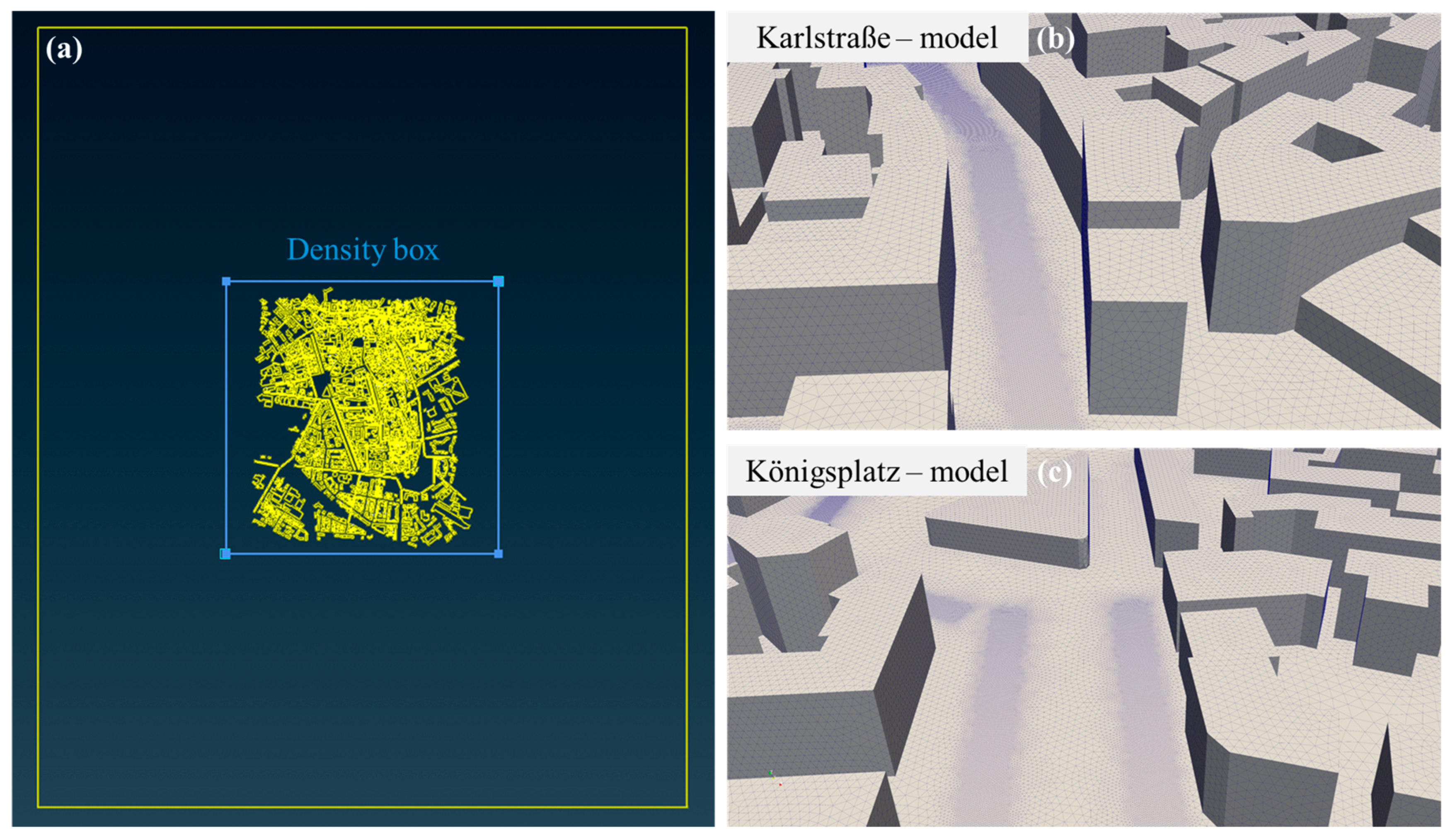
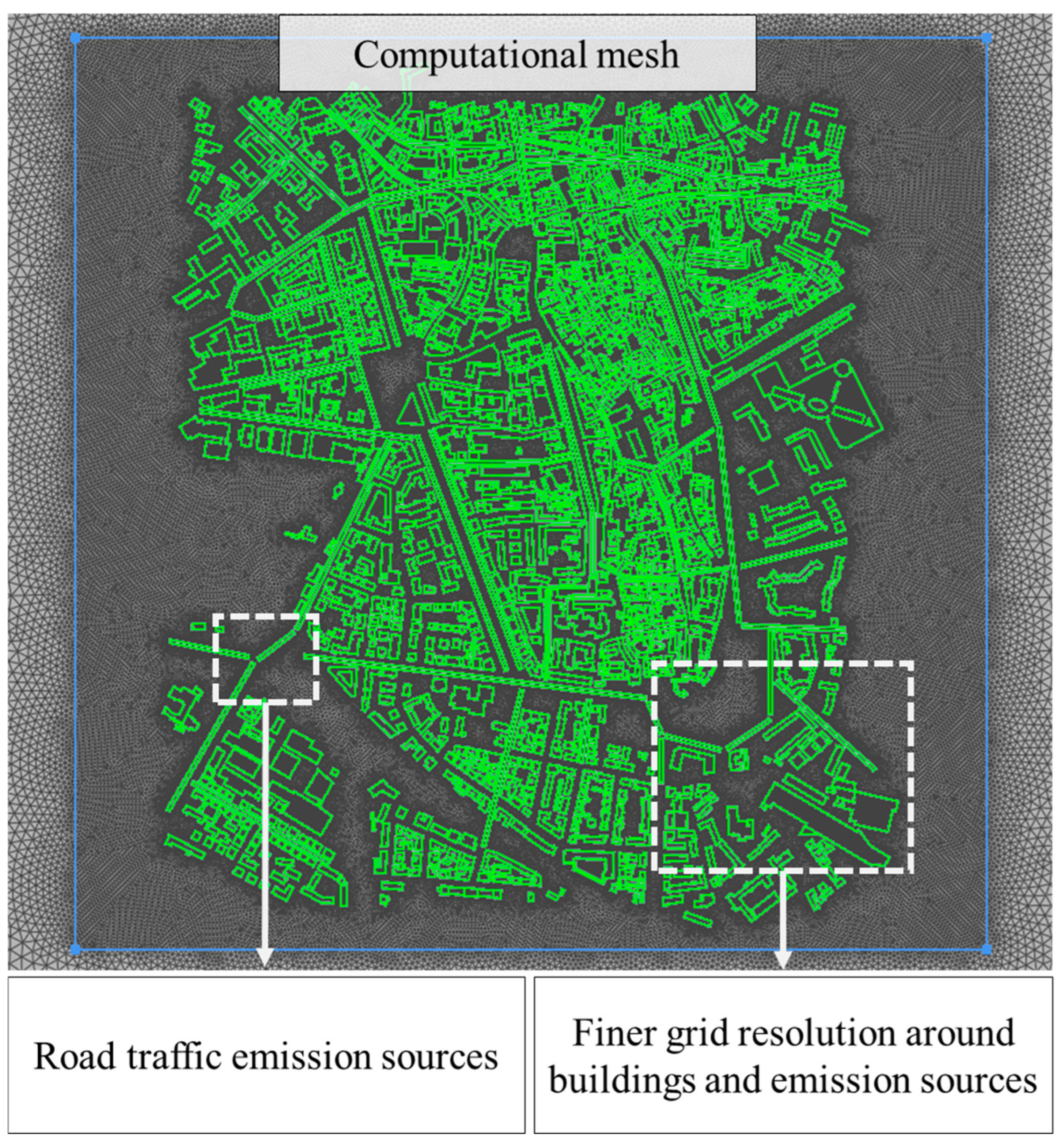
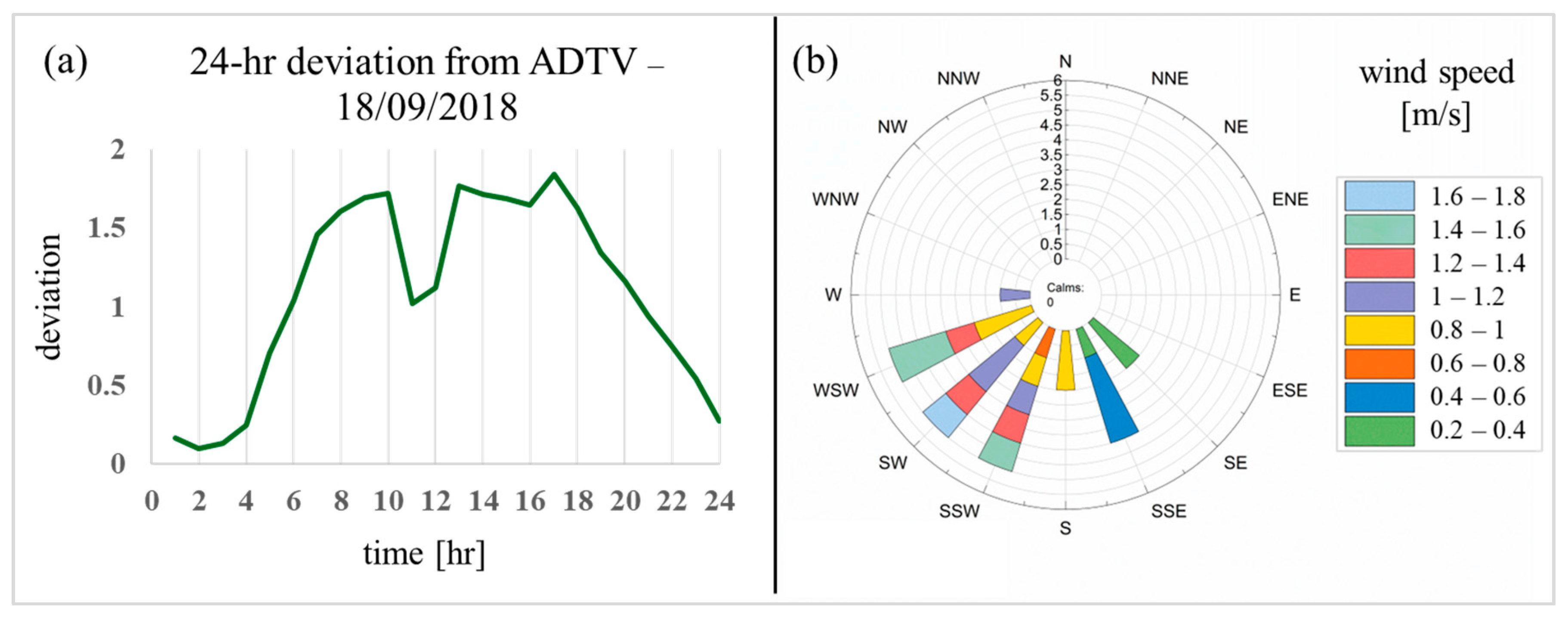
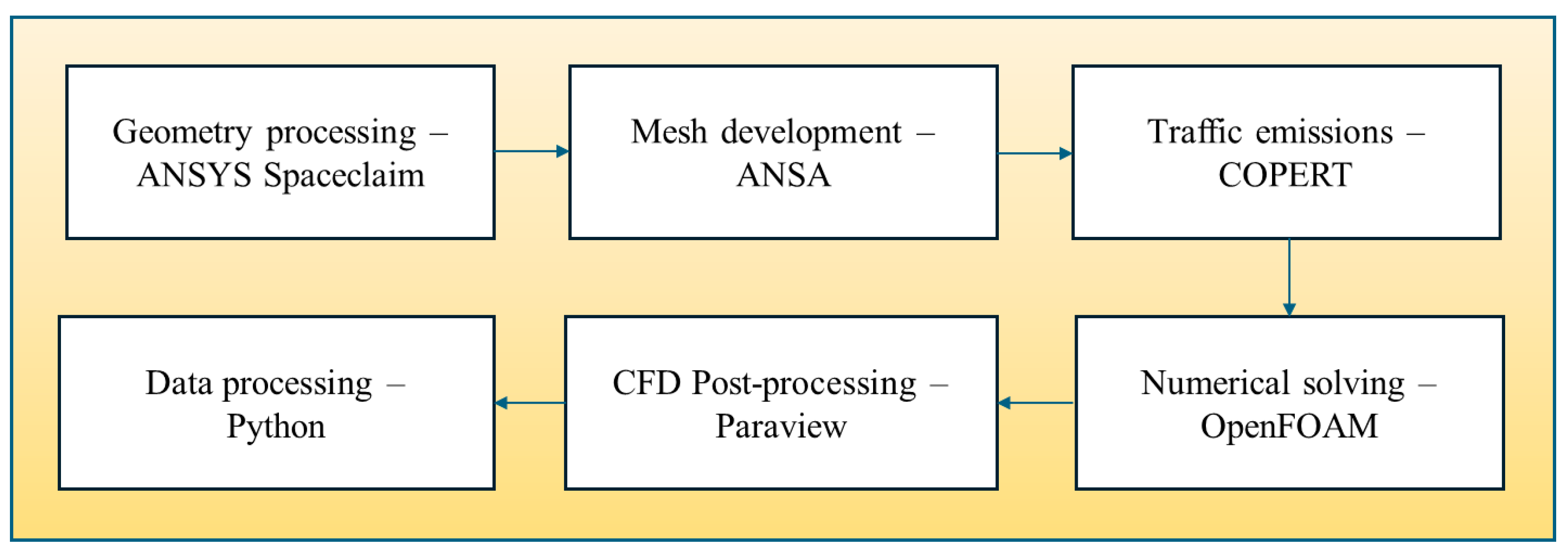
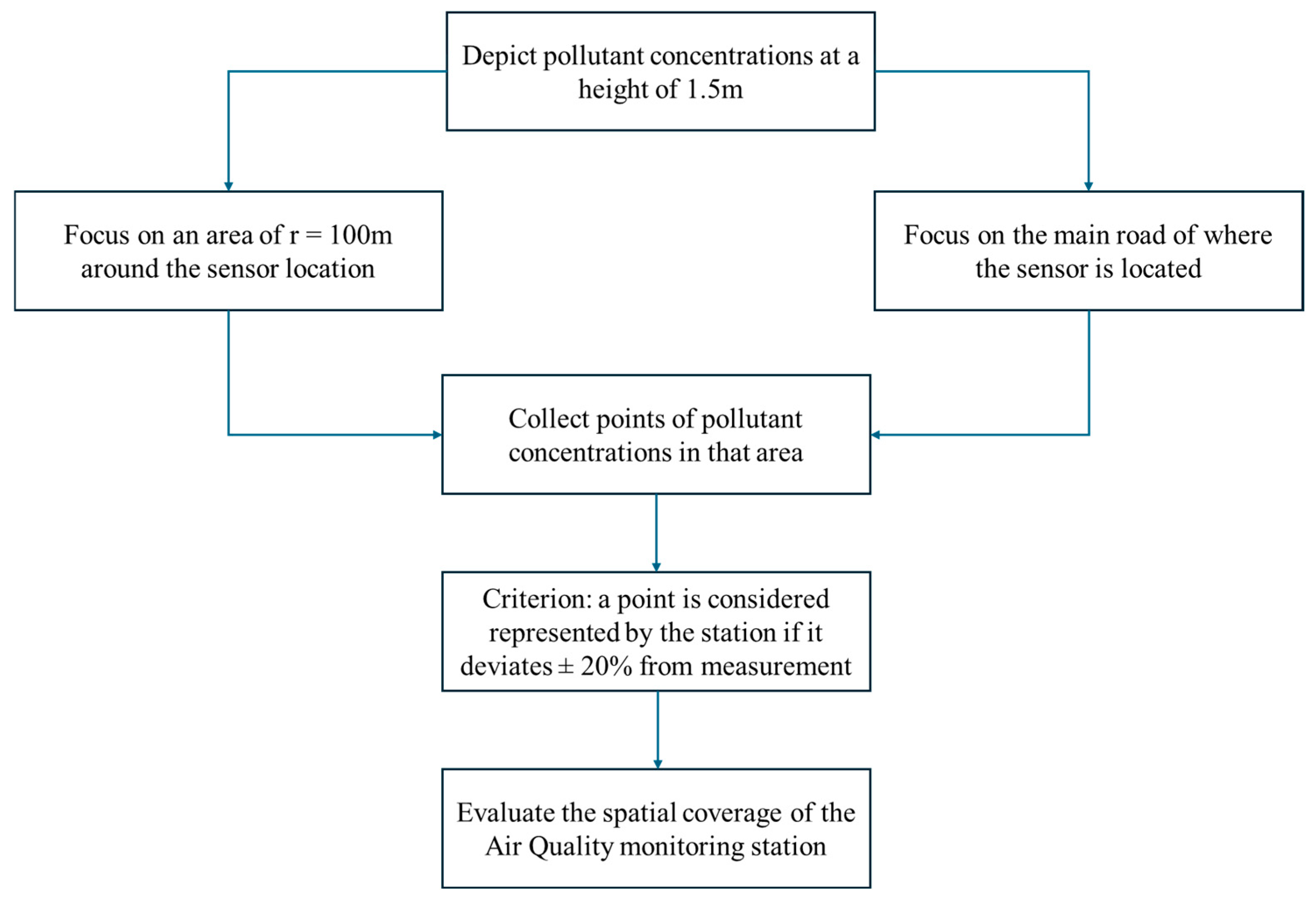

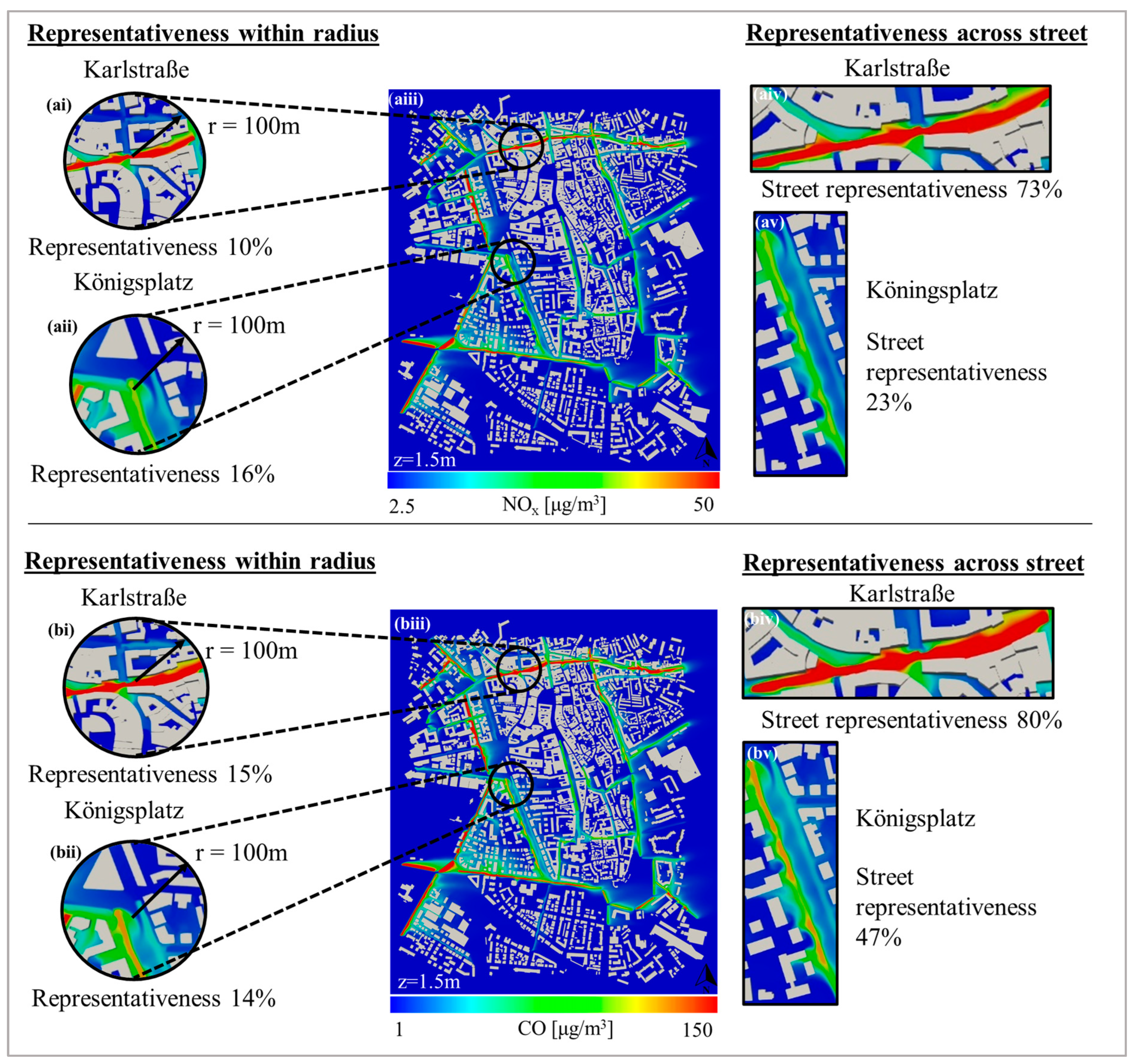
| Total CO emitted (kg/h) | 10.1 |
| Total NOx emitted (kg/h) | 3.1 |
| Wind direction (°) | 260 |
| Wind speed (m/s) | 1 |
| KS CO | KS NOx | KP CO | KP NOx | Ideal | Accepted | |
|---|---|---|---|---|---|---|
| FAC2 | 1.00 | 1.00 | 1.00 | 1.00 | 1 | ≥0.5 |
| MG | 1.01 | 1.02 | 1.01 | 1.02 | 1 | 0.7 ≤ MG ≤ 1.3 |
| VG | 1.01 | 1.01 | 1.00 | 1.01 | 1 | ≤1.6 |
Disclaimer/Publisher’s Note: The statements, opinions and data contained in all publications are solely those of the individual author(s) and contributor(s) and not of MDPI and/or the editor(s). MDPI and/or the editor(s) disclaim responsibility for any injury to people or property resulting from any ideas, methods, instructions or products referred to in the content. |
© 2025 by the authors. Licensee MDPI, Basel, Switzerland. This article is an open access article distributed under the terms and conditions of the Creative Commons Attribution (CC BY) license (https://creativecommons.org/licenses/by/4.0/).
Share and Cite
Ioannidis, G.; Tremper, P.; Li, C.; Riedel, T.; Rapkos, N.; Boikos, C.; Ntziachristos, L. Evaluating the Spatial Coverage of Air Quality Monitoring Stations Using Computational Fluid Dynamics. Atmosphere 2025, 16, 326. https://doi.org/10.3390/atmos16030326
Ioannidis G, Tremper P, Li C, Riedel T, Rapkos N, Boikos C, Ntziachristos L. Evaluating the Spatial Coverage of Air Quality Monitoring Stations Using Computational Fluid Dynamics. Atmosphere. 2025; 16(3):326. https://doi.org/10.3390/atmos16030326
Chicago/Turabian StyleIoannidis, Giannis, Paul Tremper, Chaofan Li, Till Riedel, Nikolaos Rapkos, Christos Boikos, and Leonidas Ntziachristos. 2025. "Evaluating the Spatial Coverage of Air Quality Monitoring Stations Using Computational Fluid Dynamics" Atmosphere 16, no. 3: 326. https://doi.org/10.3390/atmos16030326
APA StyleIoannidis, G., Tremper, P., Li, C., Riedel, T., Rapkos, N., Boikos, C., & Ntziachristos, L. (2025). Evaluating the Spatial Coverage of Air Quality Monitoring Stations Using Computational Fluid Dynamics. Atmosphere, 16(3), 326. https://doi.org/10.3390/atmos16030326






